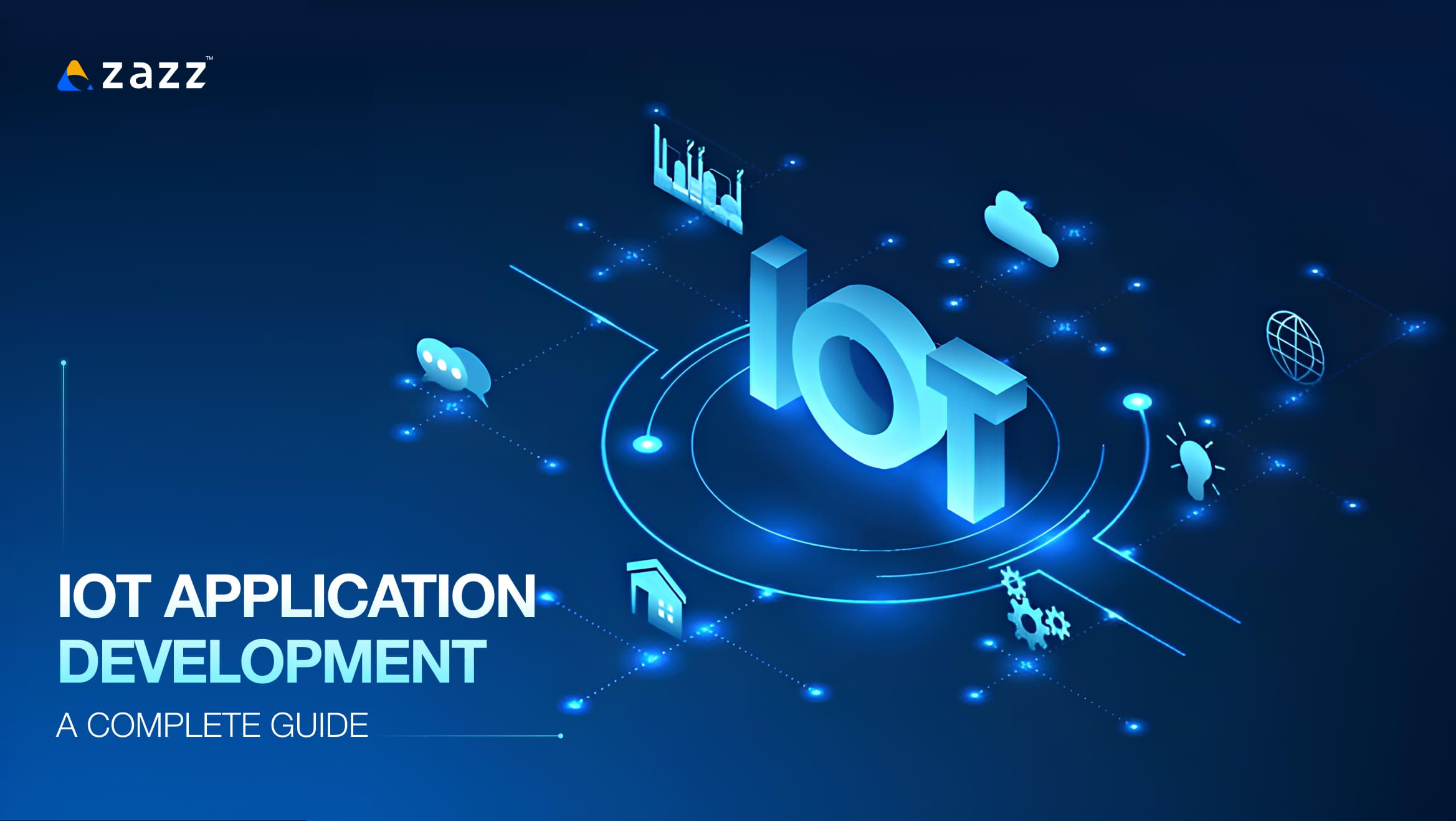
In 2024, there are already 17.08 billion connected Internet of Things (IoT) devices around the world, and that number is expected to soar to 29.42 billion by 2030. With the market value hitting $714.8 billion in the same year, it’s clear the IoT space is booming.
If you’re venturing into creating an IoT device, prepare for fierce competition. The key to success? Developing a standout IoT app.
What exactly is an IoT app, how can you create one, and what are the latest trends in the IoT industry? In this guide, we’ll cover these topics and offer a step-by-step approach to building an IoT app that your users will adore.
Let’s get started!
What is an IoT App?
An IoT app, or Internet of Things application, refers to software that allows users to interact with and control connected devices and systems. These apps act as the interface between the user and the IoT ecosystem. They enable remote management, monitoring, and analysis of various devices connected through the internet.
For example, consider a smart home system. An IoT app development in this context could allow users to control lighting, heating, security systems, and other connected devices right from their smartphone or tablet. The app acts as a central interface where all devices connect, share information, and respond to user commands. This automation of everyday tasks enhances both convenience and efficiency.
How Does an IoT App Work?
An IoT app connects to IoT devices, collects and processes data, displays it, and lets you manage the devices based on your inputs. It’s designed to make using and controlling connected devices easy and efficient. Here’s how it works:
Data Collection
IoT devices collect various types of data like location, movement, temperature, and humidity. This data is then sent to the IoT app over the internet.
Data Processing
Once the data is collected, the IoT app analyzes it to pull out useful information. It might use different methods like algorithms or machine learning to make sense of the data. Processing vast amounts of IoT information requires specialized big data services to effectively analyze and derive actionable insights from the collected data streams.
User Interface
The data that’s been processed is shown to you in a way that’s easy to understand. This could be on a computer, a website, or a mobile app.
User Input
You can interact with the IoT app by making commands, like setting the temperature, turning on a light, or changing device settings.
Device Control
Based on what you tell it to do, the IoT app sends instructions to the devices. For instance, if you want to switch on a light, the app sends a signal to turn the light on.
Data Storage
The IoT app helps save the processed data in a database. This is useful for looking back at past data and further analysis.
Security
In IoT mobile app development, using strong security measures is important. This includes secure communication, proper user authentication, and controlling who can access the app to prevent data breaches and unauthorized access.
Related reading: Internet of Things: Threats and Security Challenges to Overcome
10 Main Components of Custom IoT App Development
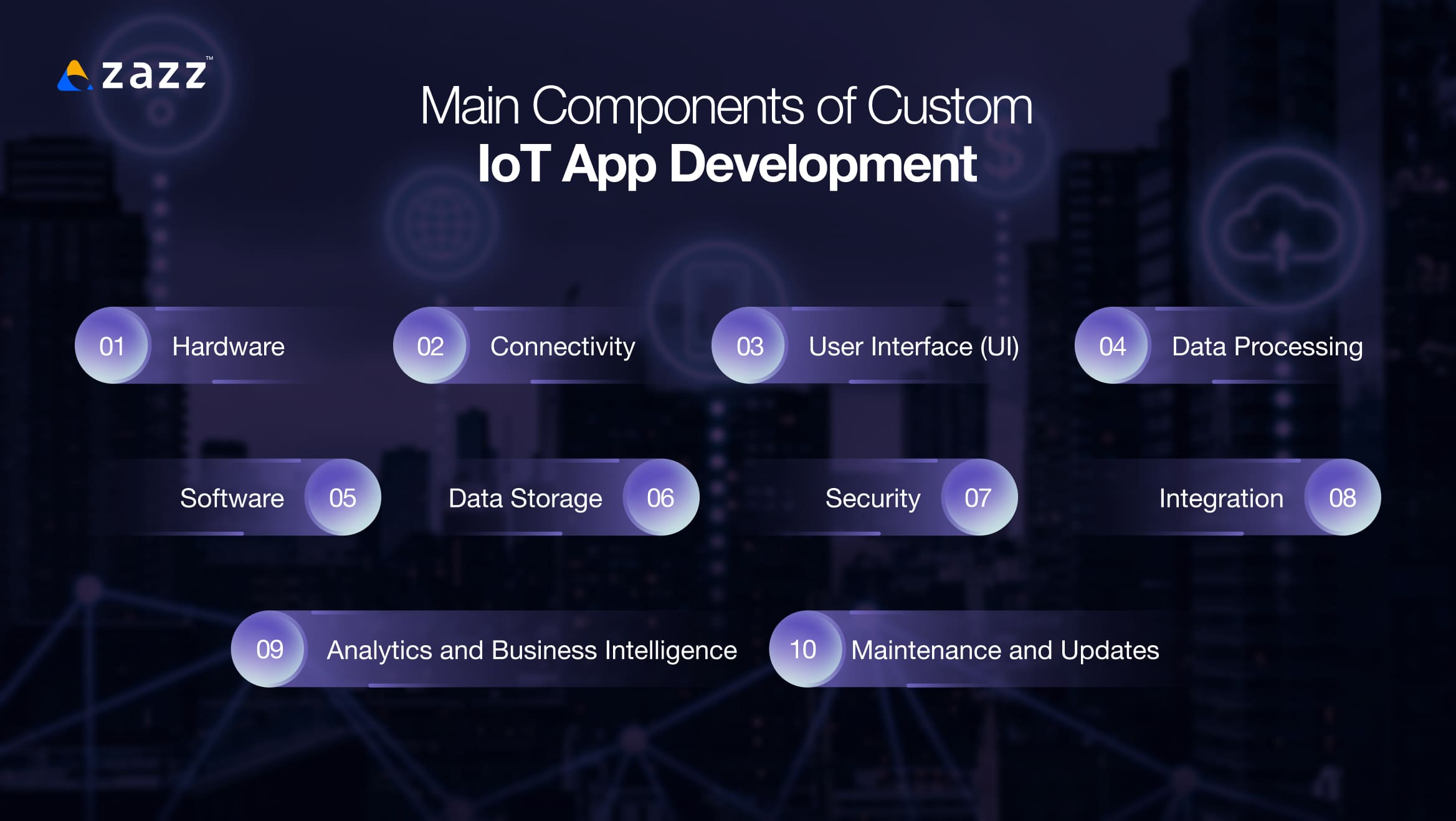
Developing an Internet of Things (IoT) application involves several key components that work together to create effective and efficient systems. Here are the essential elements:
Hardware
This includes the physical devices and sensors involved in the custom IoT app development. Hardware can range from simple temperature sensors to complex industrial machines, depending on the application. These devices gather real-world data and often perform some level of initial data processing.
Connectivity
IoT devices need to connect to the internet or other networks to transmit data. Connectivity can be achieved through various means, including Wi-Fi, Bluetooth, cellular networks, or other IoT-specific communication protocols like Zigbee or LoRaWAN.
Data Processing
Once data is collected, it needs to be processed to turn raw data into actionable insights. This can be done at the device level (edge computing) or in the cloud. Processing might involve data cleaning, analysis, and applying machine learning algorithms or other analytics techniques.
User Interface (UI)
The user interface is the part of the application that users interact with. In IoT mobile app development, the UI needs to be intuitive and capable of displaying data in a clear and actionable manner. It can be a mobile app, web portal, or even a desktop application.
Software
At the heart of an IoT system is its software. This includes the firmware running on the devices, the backend services processing the data, and the front-end interfaces. Software development for IoT encompasses programming for devices, API integration, backend server configuration, and front-end development.
Data Storage
IoT applications often generate large volumes of data that need to be stored securely and efficiently. Depending on the requirements, data can be stored on the device, on-premises servers, or in the cloud.
Security
Given the potentially sensitive nature of IoT data and the risk of unauthorized access, robust security measures are crucial. This includes secure data transmission, encrypted storage, user authentication, and regular security updates to protect against vulnerabilities.
Analytics and Business Intelligence
When it comes to mobile app development for IoT, the ultimate goal is to gather insights that help make informed business decisions. Integrating analytics and business intelligence capabilities can help organizations make sense of data and apply it to improve operational efficiency, user experience, and more.
Integration
IoT applications often need to integrate with existing business systems such as ERP, CRM, or data analytics platforms. This integration allows for more seamless operations and better data utilization across different parts of the organization.
Maintenance and Updates
After deployment, IoT systems require ongoing maintenance to ensure they continue to function correctly and securely. This includes managing updates to hardware and software, monitoring system performance, and troubleshooting issues as they arise.
Related reading: IoT Transforming Hospitality Industry
Modern Trends in IoT App Development
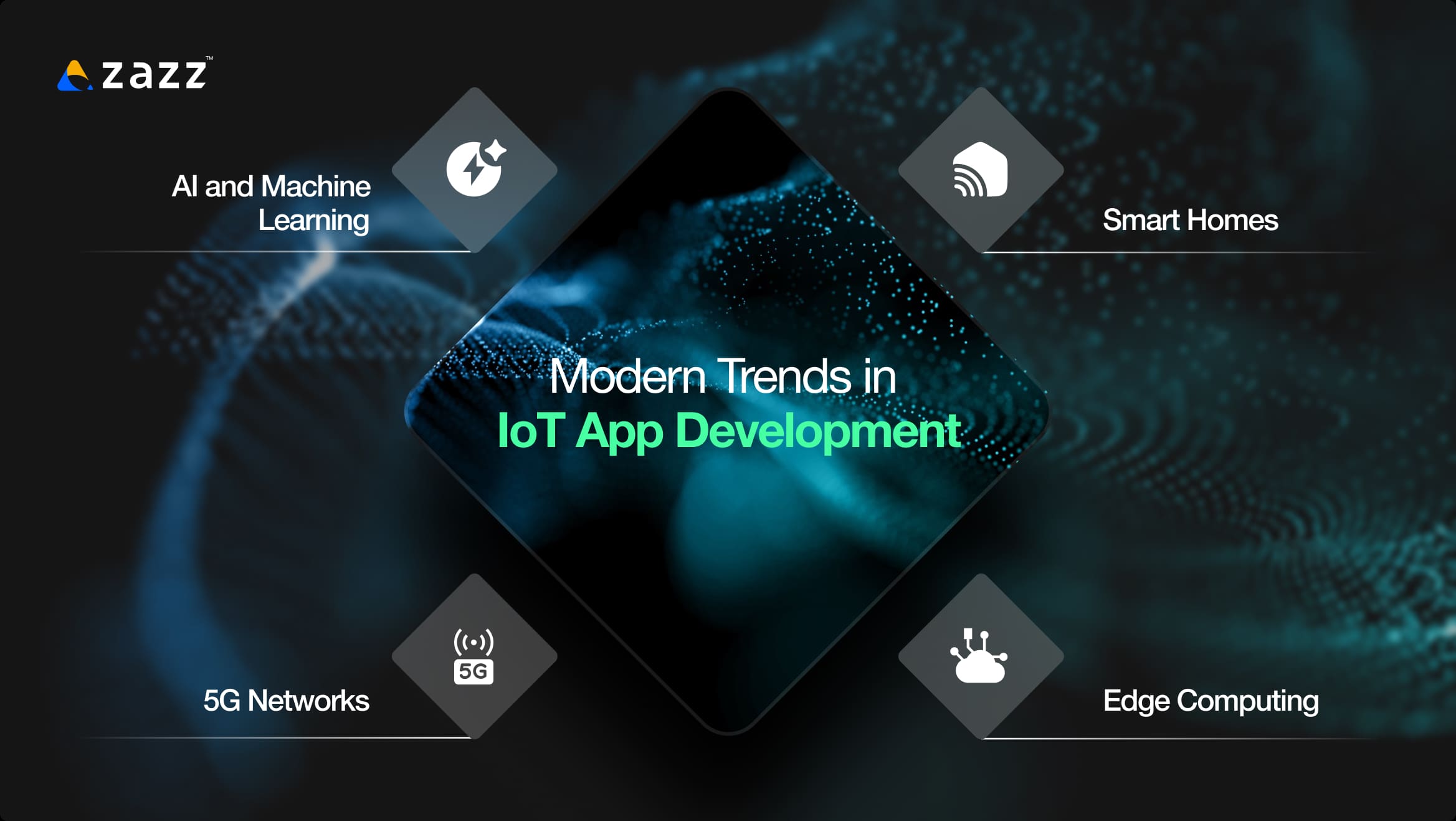
Businesses are using new technologies in mobile app development for IoT to improve efficiency and achieve better results. Here are some of the latest trends with examples:
AI and Machine Learning
Artificial intelligence and machine learning are becoming more important in Internet of Things app development. These technologies allow sensors and machines to analyze data instantly and make decisions on their own. For example, in manufacturing, AI-powered IoT devices can monitor machinery and predict when maintenance is needed. This helps prevent breakdowns and save costs. Similarly, in agriculture, AI can help analyze soil data to optimize irrigation and improve crop yields.
Smart Homes
Many IoT apps aim to create smart homes. Sensors and devices help manage energy use and daily tasks, making life easier for residents and reducing the environmental impact in cities. For instance, smart thermostats learn your schedule and adjust the temperature automatically to save energy. Additionally, smart security systems use cameras and motion detectors to monitor homes and alert homeowners of any unusual activity, providing peace of mind.
Edge Computing
Edge computing allows data to be processed and analyzed closer to where it is created. This speeds up processing and improves the performance of IoT applications. For example, in autonomous vehicles, edge computing processes data from sensors in real-time to make quick driving decisions.
5G Networks
5G networks provide faster and more reliable connections for IoT devices. This supports advanced applications like self-driving cars and robots used in remote surgery. For example, with 5G, self-driving cars can communicate with each other and with traffic systems instantly, improving safety and efficiency on the roads. In healthcare, 5G enables surgeons to perform remote operations using robotic tools with minimal delay, expanding access to specialized medical care. Moreover, in the entertainment industry, 5G can enhance virtual and augmented reality experiences by providing the high-speed data transfer needed for seamless interactions.
Industries Utilizing IoT Technology
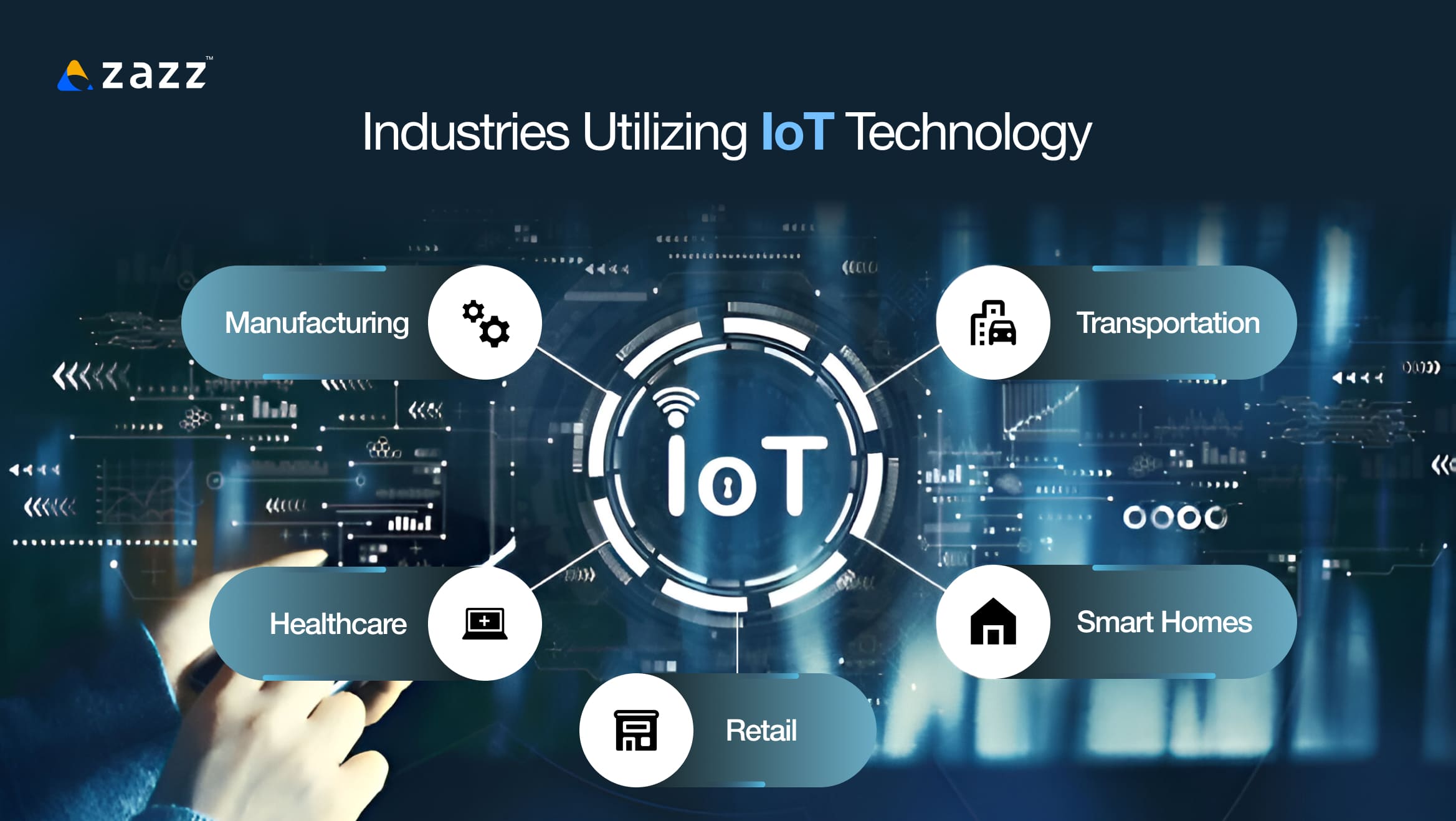
The landscape of IoT app development is vast, with its influence permeating multiple industries. This diversity demonstrates IoT’s adaptability and its potential to transform various fields. Here’s the list of a few industries where IoT is being utilized:
Transportation
IoT sensors and devices are widely used in the transportation sector to monitor fuel consumption, vehicle performance, and traffic conditions. According to a report by MarketsandMarkets, the IoT in the transportation market is expected to grow from $42.2 billion in 2021 to $68 billion by 2026, at a CAGR of 10%. These technologies can help reduce traffic congestion, enhance safety, and lower pollution levels by optimizing routes and improving vehicle maintenance. Reliable custom software development company deliver IoT solutions that streamline traffic management systems and optimize urban mobility.
Smart Homes
In the smart home industry, IoT devices and sensors manage and monitor various aspects such as entertainment systems, security, lighting, and temperature control. The Smart Homes market is valued at $120.10 billion in 2024 and is expected to grow to $225.82 billion by 2029. This represents an annual growth rate of 11.09% from 2024 to 2029. These devices provide homeowners with convenience, energy savings, and enhanced security through automated and remote control features.
Manufacturing
Internet of Things app development plays a crucial role in manufacturing by improving supply chain management, increasing manufacturing efficiency, and enabling real-time equipment monitoring and control. This leads to reduced downtime, better quality control, and higher overall productivity in manufacturing operations.
Healthcare
In the healthcare sector, IoT devices such as smart wearables, electronic health records, and remote patient monitoring systems track patient health, identify potential health issues, and enhance medical care. According to a report by Statista, the global healthcare IoT market is projected to grow from $61 billion in 2019 to $260 billion by 2027. These technologies enable continuous health monitoring, improve patient outcomes, and streamline healthcare services.
Retail
Retailers use IoT devices to enhance customer experiences, improve operational efficiency, and optimize supply chain management. Features like targeted marketing, smart shelving, and automated checkout systems are becoming standard. The IoT in retail market is expected to grow from $14.5 billion in 2020 to $35.5 billion by 2025, at a CAGR of 19.6%. These technologies help retailers better understand customer behavior, manage inventory more effectively, and provide personalized shopping experiences.
Related reading: Guide to Mobile App Backend Development
8 Essential Steps to Build an IoT App
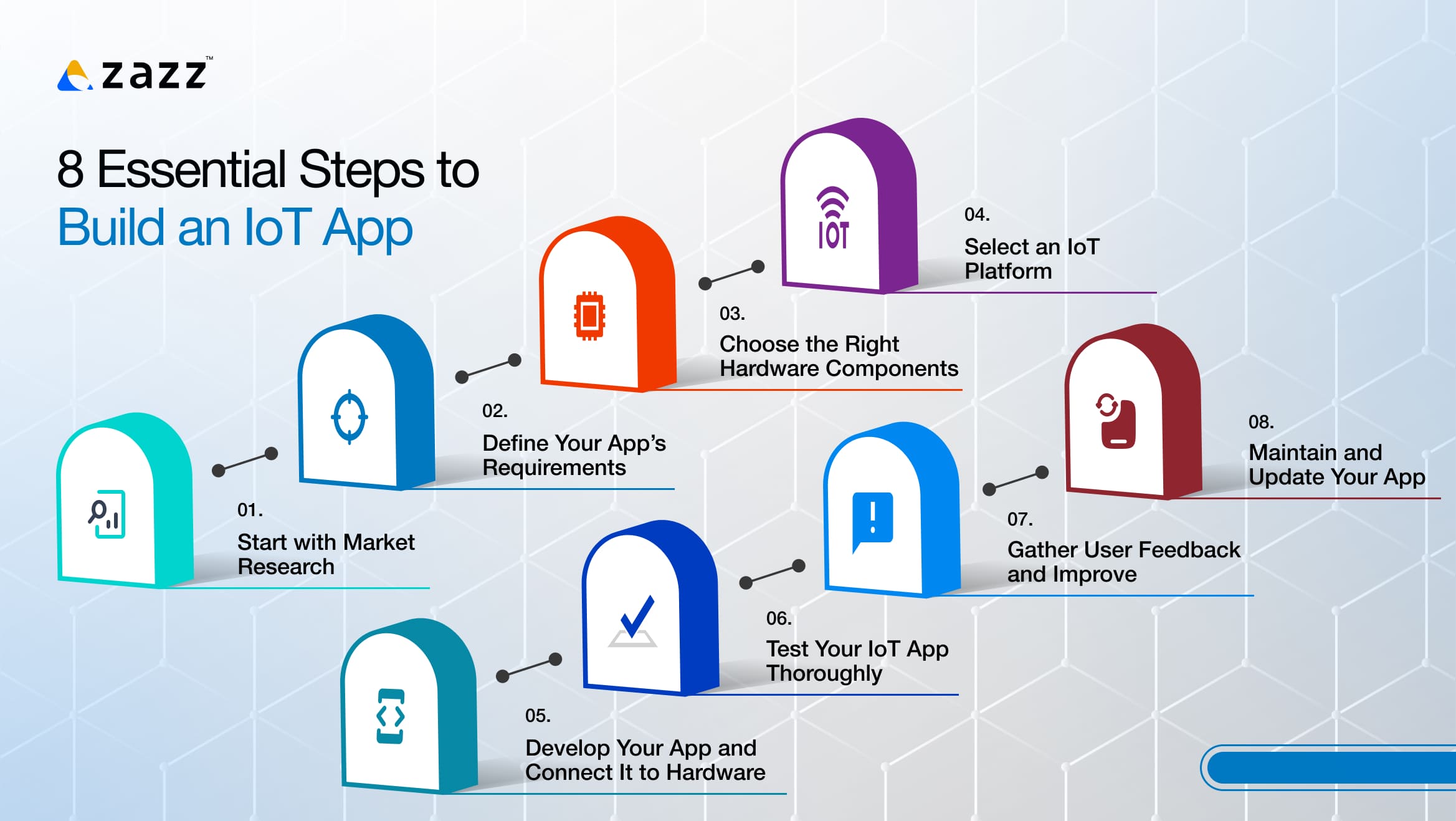
Creating an IoT app involves several important steps to ensure it works smoothly and meets user needs. Here’s a simple guide to help you develop your IoT application:
Start with Market Research
Before you get started with Internet of Things app development,, it’s important to understand who your target users are and what they need. Conducting market research helps you identify your audience, learn their preferences, and find out how your app can solve their problems. This step helps make sure your app will be successful and meet the demands of your users.
Define Your App’s Requirements
Once you know who you’re building for, the next step is to outline what your app needs to do. Create a detailed list of features and functionalities your app should have. This includes both what the app will do (like monitoring data or controlling devices) and how it will perform (such as speed and security). Clear requirements guide your development process and keep your team focused.
Choose the Right Hardware Components
Choosing the right hardware is important for your IoT app. Depending on what your app does, you may need sensors, actuators, microcontrollers, communication modules, power supplies, memory storage, and displays. Make sure these components work well together and are compatible with your app’s platform. Good hardware makes your app work better and easier to maintain.
Select an IoT Platform
An IoT platform links your devices to your app and provides tools to manage them. Pick a platform that meets your specific needs, such as managing devices, handling data, and ensuring security. Popular IoT platforms include Microsoft Azure IoT, AWS IoT, ThingWorx, and Cumulocity IoT. The right platform makes it easier to develop, launch, and grow your IoT app.
Develop Your App and Connect It to Hardware
Once your requirements are set and hardware chosen, you can begin building your app. Develop the front-end (what users see and interact with) and the back-end (the server-side operations) of your app. Make sure your app can communicate properly with your IoT devices through APIs or other methods. This step turns your ideas into a working application.
Test Your IoT App Thoroughly
Testing is an important part of developing any app, especially IoT apps with many parts. Perform different types of tests, such as functional tests to make sure everything works correctly, security tests to protect data, and performance tests to check the app’s speed and reliability. Early and thorough testing helps you find and fix issues before your app is launched.
Gather User Feedback and Improve
After launching your IoT app, keep collecting feedback from users. Use surveys, reviews, and direct feedback to learn what users like and what needs to be better. Regularly update your app based on this feedback to improve its features and performance. This ongoing improvement helps keep your app useful and up-to-date for your users.
Maintain and Update Your App
Creating your IoT app is only the first step. Regular maintenance and updates are needed to keep your app running well and securely. Watch the app’s performance, fix any problems that come up, and add new features when needed. Keeping your app up-to-date makes sure it continues to meet user needs and adapts to changes in technology or the market.
Challenges in Building an IoT App
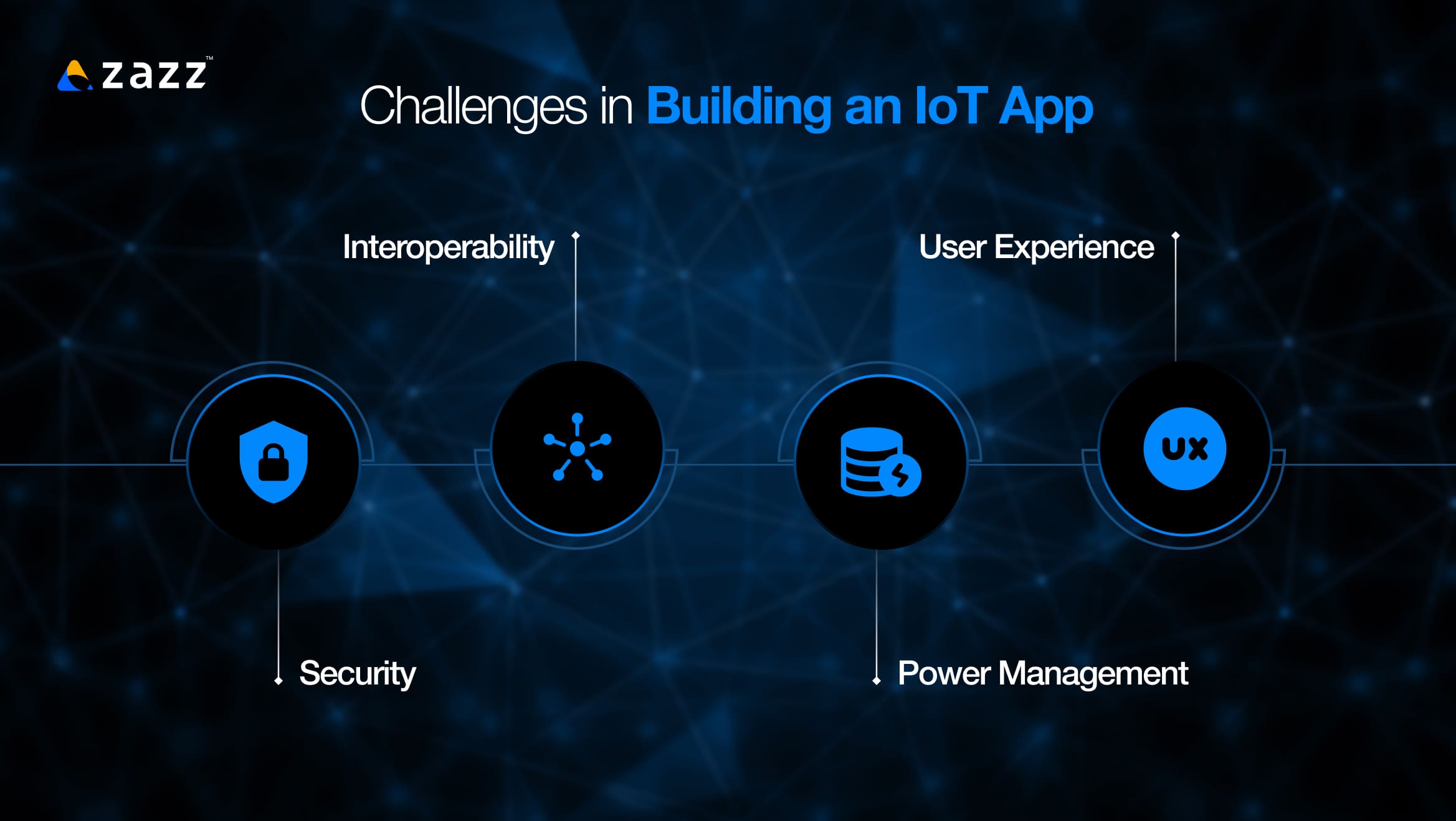
Building an IoT app comes with several challenges that you need to address to ensure it works effectively and meets user expectations. Here are the main obstacles you might encounter:
Security
Ensuring the security of your IoT app is a major concern. IoT devices and apps can be more vulnerable than standard applications because they are often spread out and may have weaker security measures. Common security issues include:
- Data Breaches: Unauthorized access to sensitive information.
- Device Hacking: Control of devices by malicious actors.
- Weak Authentication: Inadequate password protection and lack of multi-factor authentication.
To protect your app and users, consider the following measures:
- End-to-End Encryption: Protect data as it travels between devices and your app.
- Regular Updates: Keep your software up-to-date with the latest security patches.
- Strong Authentication: Use multi-factor authentication and enforce strong password policies.
- Security Audits: Regularly check your system for vulnerabilities through security assessments and testing.
Interoperability
IoT ecosystems consist of various devices and components that need to communicate seamlessly. Different manufacturers may use different communication protocols, making it difficult for all parts to work together. To address this:
- Standard Protocols: Use common communication standards like HTTP, MQTT, or CoAP to ensure compatibility.
- APIs: Develop clear and reliable APIs to facilitate communication between devices and your app.
- Middleware Solutions: Implement middleware to bridge different systems and protocols.
- Certified Components: Choose components certified by recognized organizations to ensure they meet interoperability standards.
Power Management
Many IoT devices rely on batteries, making power management a critical aspect of app development. Efficient power usage ensures devices remain operational longer and reduces the need for frequent recharging or battery replacements. Strategies include:
- Energy-Efficient Hardware: Choose components that consume less power.
- Optimized Software: Design your app to minimize power usage, such as reducing background processes and optimizing data transmission.
User Experience
Creating a user-friendly IoT app is essential for its success. The app should be intuitive and easy to use, providing a seamless experience for users interacting with their devices. Focus on:
- Simple Interface: Design a clear and straightforward user interface.
- Reliable Performance: Ensure the app responds quickly and functions smoothly.
- User Support: Provide resources and support to help users navigate and troubleshoot the app.
Related reading: What is DevOps Automation?
How Zazz Can Assist You in IoT App Development Services
At Zazz, we help you with Internet of Things application development that works smoothly and meet your business needs. Our experienced team takes care of everything from designing the app to connecting it with your devices. We focus on making your app secure and capable of handling large amounts of data, addressing the common challenges in IoT development.Additionally, Zazz provides ongoing support and maintenance to ensure your app stays up-to-date and runs efficiently. Whether you’re starting a new IoT project or enhancing an existing one, Zazz is here to support you every step of the way. Reach out to us today and let Zazz help you create a successful IoT application tailored to your business.
Frequently Asked Questions
An IoT app is software that allows users to interact with and control connected devices and systems. It serves as the interface between the user and the IoT ecosystem, enabling remote management, monitoring, and data analysis.
Internet of Things application development can help automate processes, improve efficiency, reduce costs, and provide valuable insights through data collection and analysis. It enhances the way you interact with your devices and can lead to better decision-making.
The development time varies based on the complexity of the app and the features you need. A simple IoT app might take a few months, while more complex applications with advanced functionalities could take longer. Zazz works with you to establish a realistic timeline based on your specific project requirements.
Some common challenges in app development IoT include ensuring security, managing and scaling data, achieving interoperability between different devices and systems, maintaining power efficiency, and providing a seamless user experience.
Zazz implements strong security measures such as end-to-end encryption, regular software updates, multi-factor authentication, and thorough security audits. These steps help protect your app and user data from potential threats.
Yes, Zazz can assist in integrating your IoT app with your current business systems like ERP, CRM, or data analytics platforms. This integration ensures smooth operations and better data utilization across your organization.
Various industries can benefit, including transportation, smart homes, manufacturing, healthcare, and retail. IoT apps can enhance operations, improve customer experiences, and provide valuable insights across these sectors.
Recent Articles
Table of Content 1. Data Engineer vs. Data Scientist: Understanding...
Table of Content 1. What is the Carnival in Brazil?...
Table of Content 1. What is IT Staff Augmentation? 2....












